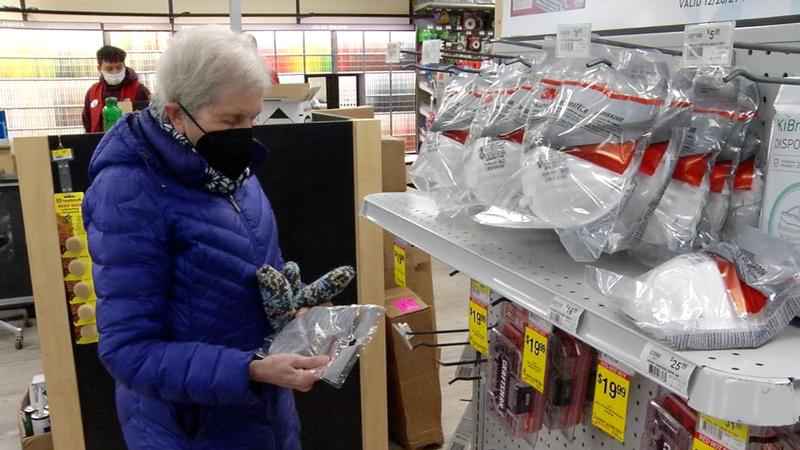Experts: How, when to wash and reuse N95, KN95 masks
MaryKay Schladweiler is on a mission.
"I came in to look at snow shovels and masks," she says. "Somebody told me this hardware store has masks."
She’s among those scouring the shelves of a south Minneapolis hardware store for a mask upgrade.
"I have a cloth one right now," adds Richard Hicks, who lives nearby. "It’s got an inner liner, but I was going to switch over to the N95."
These two aren’t alone.

[KSTP-TV]
Next week, the Biden administration will start making 400 million N95 masks available for free to U.S. residents.
With omicron variant numbers rising, many health experts are urging people to switch from cloth masks to an N95 or KN95 mask.
"Good masks are critical right now," says Joe Kurland, infectious disease preventionist with Children’s Minnesota.
Experts say the woven materials in cloth masks block only 10-35% of viral droplets.
"We really want to encourage individuals to move away from cloth masks or homemade masks or even fabric masks you buy in the stores," Kurland adds.
Scientists say both N95s and KN95s not only have a denser weave able to filter out 95% of airborne particles — hence the name — but they’re also made from a plastic material called polypropylene that has an embedded electric charge.
"Part of the fiber will have some positive charge and part of the fiber will have some negative charge," says Chris Hogan, an aerosol expert with the University of Minnesota.
He says the N95 and KN95 masks use a process called electrostatic absorption, where those electric charges attract foreign particles, including viral droplets — trapping them inside the mask fibers.
"Small particles, even if they don’t have a charge, they are attracted to the fiber for that reason, and so it helps with a collection of particles of all sizes," Hogan explains. "That’s why they’re 95% efficient or actually better for a lot of particle sizes."
Mask users like Hicks say that’s all well and good — but for him, the N95 is a disposable, temporary measure.
"For me, I just throw them away," he says. "I’ll use them for, I don’t know a few days, then I’ll switch out."
We wondered after all that washing and drying of cloth masks if N95s and KN95s could be reusable.
Schladweiler says she has her own technique.
"Put them in a paper bag and leave them in there for one day to five days," she says.
Experts say Schladweiler is right — sort of.
"It does look like after a three-day duration, most of the virus that’s there would be non-viable," Hogan says.
We asked him to read through an article from the Journal of Emergency Medicine. It says you can rotate your masks and that the COVID-19 virus on them will be dead in three days.
Some experts suggest you buy a pack, mark each mask with a number and rotate them every day to make sure your supply lasts longer.
"One of the things they mentioned was rotating through three or four masks," Hogan notes. "It does look like after a three-day duration, most of the virus that’s there would be non-viable. It’s difficult to say 100%, but most of it would be."
The Centers for Disease Control recommends that you don’t use N95 or KN95 masks more than five times.
The agency says deterioration of the mask or any fraying of the straps are signs you should toss them out.
"The N95 respirator is a really excellent mask, with its ability to collect particles," Hogan says. "Provided that you can rotate through them, you can use them for a while until you have physical damage."
The journal study also says boiling your masks for five minutes, keeping the straps out of the water, will kill the virus — or, it says, you can bake them at 158 degrees Fahrenheit for an hour.
The article includes a photo of a hospital blanket warmer with a row of masks hung from a wooden dowel.
Hogan says these ideas really work, as long as you don’t go overboard with the heat.
"The one I actually liked was the oven heat treatment the most because it didn’t involve any sort of water vapor," he says. "Those have potential to be effective cleaning mechanisms."
Schladweiler says she’s not totally sold on the baking or boiling technique.
"No, I don’t think I’d try that," she smiled. "Paper bags are much easier."
Hogan says, unlike cloth masks, you should never use soap and water on your N95s or KN95s.
"So much of their high efficiency is related to this charge distribution, this electrostatic mechanism," he says. "Any sort of chemical cleaner or even water that we add to this can remove that charge. We can literally clean it away."
But what about people who want to double mask, using a cloth mask and a surgical mask?
The CDC says double masking blocks about 85% of viral particles. The agency says that number increases to 95% if two people in close quarters are double masking.
The CDC says N95 and KN95 masks offer the best protection against COVID-19.
As for Schladweiler?
She says for her, mask maintenance will be more work-intensive now.
But she’s okay with that.
"Absolutely," Schladweiler declares. "Because I don’t think the risk or not wearing these safer masks is worth it."